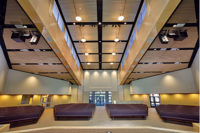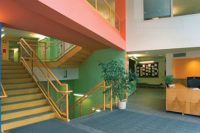Until now, acoustics in commercial office buildings have not been a formal part of the LEED rating systems except on a case-by-case basis with possible credits in the Innovation in Design or Pilot Credit 24 categories. The new LEED v4 criteria, however, now takes into account the value of good acoustics in enhancing occupant satisfaction and productivity.
Under LEED v4, it is now possible to qualify for two points toward the Acoustic Performance credit in the Indoor Environmental Quality section of the new Interior Design and Construction (Commercial Interiors) rating system, and one point in the new Building Design and Construction (New Construction) system.
Occupant Survey Results
The addition of acoustic performance to these systems recognizes the results of occupant surveys the Center for the Built Environment has conducted over the years. For example, CBE surveyed nearly 22,000 occupants in U.S. commercial office buildings and found acoustic quality to be the only negative factor in terms of the indoor environment. On a scale of +3.0 (satisfied) to -3.0 (dissatisfied), acoustics scored -0.30.
Additionally, nearly 5,000 occupants were surveyed in LEED-certified office buildings, and acoustics were once again the only negative factor (-0.35). In terms of acoustics, there is little differentiation between LEED and non-LEED buildings.
CBE survey results in office buildings also show that the higher the LEED certification level, the lower the occupant satisfaction with acoustics. Acoustic satisfaction was -0.53 in Platinum buildings, -0.47 in Gold, and -0.16 in Silver. As architects strive for higher certification levels, acoustics seem to be overlooked in preference to accumulating points.
Open or Closed Plan Spaces
Improving the acoustic environment of commercial office spaces to meet the LEED criteria is not difficult as long as attention is paid to matching the performance features of the ceiling to the needs of the space.
One of the best solutions for keeping noise levels down and conversations private in either open or closed plan spaces is the use of high performance acoustical ceiling panels that combine the right mix of Noise Reduction Coefficient and Ceiling Attenuation Class.
The NRC indicates the ability of a ceiling to absorb sound. It is expressed as a number between 0.00 and 1.00, and indicates the average percentage of sound it absorbs. A ceiling with an NRC less than 0.50 is considered low performance, one with an NRC of 0.70 or greater, high performance.
The CAC indicates the ability of a ceiling to block sound in one space from passing up into the plenum and transmitting back down into an adjacent space that shares the same plenum. The higher the number, the better the ceiling acts as a barrier to sound intrusion between the spaces. A ceiling with a CAC of 25 or less is considered low performance, one with a CAC of 35 or greater, high performance.
The right combination of NRC and CAC values represents the best approach to ceiling selection tailored to the needs of a space. In closed plan spaces where speech privacy is essential, select ceilings with a high CAC to block sound from traveling into adjoining spaces and a moderate to high NRC to decrease unwanted sound in the space.
In open plan spaces where either focus or collaboration is key, select ceilings that have a moderate to high NRC to decrease reverberant sound and a moderate to high CAC to block sound from traveling into adjoining spaces.
Open Plenum Spaces
Design trends often call for collaborative and focus spaces in open plenum spaces, meaning those where there are no ceilings and where building service elements such as ductwork and piping are revealed. Unless the sound control normally provided by an acoustical ceiling is replaced with an alternative system, there will be acoustical problems due to sound reflecting off the deck, resulting in excessive reverberation and noise.
Large spaces of this design will need some type of sound absorbing elements to control noise and reverberation within it. In addition, if the exposed deck is less than 15 feet high, reflections between cubicles can cause distractions for nearby occupants.
Noise issues related to open plenum designs can be addressed through the installation of several kinds of sound-absorbing elements. One option is a type of discontinuous, high-NRC ceiling system designed specifically to provide excellent sound absorption while maintaining the look and feel of the exposed structure design.
These systems can be installed “tight” to an exposed deck to maximize ceiling height, directly onto drywall, or suspended with wires. When suspended over only 20 percent of an area, systems with NRC 0.90 panels may reduce reverberation up to 50 percent.
“Free-Floating” Options
Noise issues in open plenum spaces can also be addressed through the use of acoustical clouds, canopies, baffles and blades—four types of “free-floating” options that add sound absorption while still allowing for the exposed look.
All four options can absorb sound on both their front and back surfaces. As a result, they can actually provide greater sound absorption than a continuous ceiling of the same surface area.
Acoustical clouds provide a type of interrupted ceiling plane when suspended above work areas. As such, they help control both reflections between cubicles and distant reverberation, reducing occupant annoyance and distractions.
Acoustical canopies also reduce noise and reverberation in the space below them, but are much different in size and look compared to acoustical clouds. Acoustical clouds are available in standard sizes up to 14 feet by 14 feet, while acoustical canopies are usually 3 feet by 3 feet or 4 feet by 6 feet in size. Visually, acoustical clouds are flat, while canopies are curved and can be installed as hills or valleys.
Baffles and blades are suspended vertically to impart an upscale visual while providing substantial sound absorption. Installation is easy because all the components needed to suspend a baffle or blade are contained in a hanging kit.
Contribution to Other LEED Credits
Acoustical ceilings can not only contribute to the new LEED credit for Acoustic Performance, but a number of other credits as well. They include:
- Materials & Resources Construction and Demolition Waste Management—Ceiling recycling programs offer an alternative to landfill disposal.
- Materials & Resources Building Product Disclosure and Optimization—Sourcing of Raw Materials—Acoustical ceilings can contain recycled content up to 80 percent.
- Energy & Atmosphere Optimize Energy Performance—Acoustical ceilings with high light reflectance can reduce the energy required to illuminate a room.
- Indoor Environmental Quality Daylight—Acoustical ceilings with high light reflectance help “extend” natural daylight into a space.
Sustainability and Acoustics
As evidenced above, by choosing appropriate acoustical ceilings, green buildings, even those with exposed structures, can be designed to meet the high performance and sustainability demands of today’s LEED criteria, while still being sensitive to the needs of those who will occupy the building tomorrow.









Report Abusive Comment